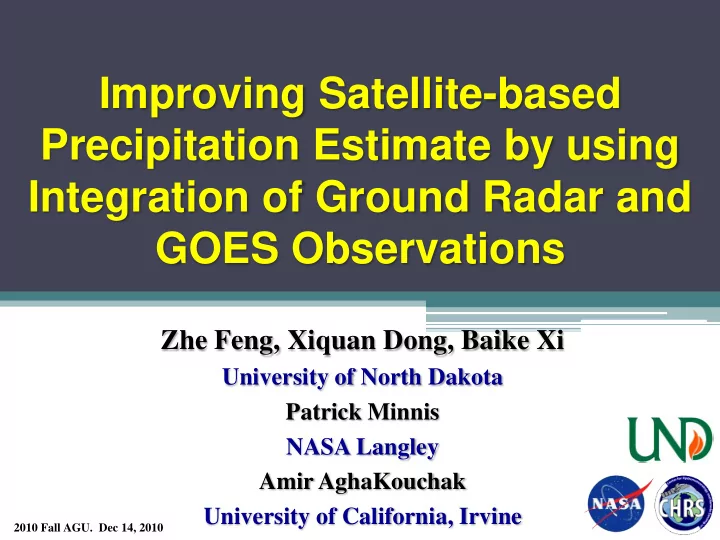

Improving Satellite-based Precipitation Estimate by using Integration of Ground Radar and GOES Observations Zhe Feng, Xiquan Dong, Baike Xi University of North Dakota Patrick Minnis NASA Langley Amir AghaKouchak University of California, Irvine 2010 Fall AGU. Dec 14, 2010
Motivation • Importance of satellite precipitation estimate ▫ Global coverage, high resolution • Issues ▫ Uncertainties in fine resolution products from optical sensor estimates ▫ Needs to be evaluated and continually improved
UCI PERSIANN CCS • IR T b based retrieval ▫ Cloud patch identification ▫ Retrieval based on patch T b features ▫ Calibrated with radar + gauges • Advantage ▫ Not rely on local pixel T b ▫ High resolution (0.04°, hourly) • Issues ▫ Assumes raining over entire identified cloud patch Hong et al. (2004)
Approach • Combine radar and GOES Observations • Classify precipitating clouds and anvil clouds • Compare CCS rainfall against surface gauges • Find insights from GOES retrieved microphysics for different cloud types • A work in progress … + Hybrid
Hybrid Classification NEXRAD GOES GOES Thin Stratiform Convective Thick Thin Dee p Anvil Anvil Anvil E ce C T E se E se E ce C cu C su Low-Level E cd E sd Rain Weak/No Rain
Mesonet Method Gauges Hybrid Classification CCS Rainfall • Match hybrid classification with CCS rainfall • Then the matched CCS rainfall is classified into different cloud types (Conv, SF, Deep, thick and thin anvils) • Finally they are compared with Mesonet gauges in Oklahoma
Use Mesonet to Find Rain Cases • Compare significant rain events in Oklahoma • Jun – Aug 2009 (37 cases) • Case must last more than 2 hours
Case Average Comparison Mesonet Case Rain % Mesonet Case Rain % • Rainfall percentage ▫ Mesonet: almost all from conv/sf ▫ CCS: significant amount from anvil CCS Case Rain % CCS Case Rain % • Simplify cloud types ▫ [Conv/Sf/DeepCld] Deep Tower: 74% ▫ Thick Anvil: 15% ▫ Thin Anvil: 8%
Average Rainfall Comparison Hourly Case Average CCS underestimate deep tower rain, overestimate anvil rain
GOES Cloud Microphysics Optical Depth Classification CCS Rainfall Ice Effective Diameter
GOES Microphysics Daytime Nighttime Thin Anvil Thin Anvil • Optical depth shows significant difference between thin anvil and other two types • Difference exist for both daytime/nighttime • Therefore the optical depths in thin anvil region may be used to improve the CCS precipitation retrieval (filter out non raining areas) • The optical depths in thick anvil and deep tower are difficult to distinguish (on pixel level)
Idealized Cloud Patch τ Gradient τ Conceptual Cloud Patch Core Distance
Conclusion & Future Work 1) CCS underestimated rain over deep convective tower and overestimated rain over anvil regions 2) The optical depths in thin anvil region can be used to improve CCS precipitation retrieval (8%) 3) GOES derived τ patch parameters will help further improve CCS cloud classification
14 Questions?
Idealized Cloud Patch τ Gradient τ Core Distance
GOES Microphysics Ice Effective Diameter IR Temperature Daytime Nighttime
Optical Depth vs. T IR
CCS Rain vs. T IR
Recommend
More recommend